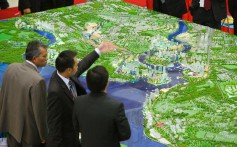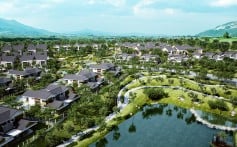Category Archives: Singapore
Singapore Property Files
Malaysia – Iskandar follows the Shenzhen script
Iskandar follows the Shenzhen script
http://www.scmp.com/business/money/markets-investing/article/1257278/iskandar-follows-shenzhen-script
Links to Hong Kong are replicated in the Malaysian economic zone’s ties to Singapore
Efforts to transform the Malaysian border zone near Singapore into a bustling commercial corridor appear to be on track after a rocky start.
The zone, known as Iskandar, is emerging as an attractive opportunity that deserves to be on the radar of those considering investment in the new growth centres of Asia.
 Iskandar is a 2,216 square kilometre urbanisation project, three times the size of Singapore. Nusajaya, the residential zone at its core, which stares across the water at the Singapore skyline, is just a 45-minute drive from Singapore’s Changi airport. The zone is geared towards a residential metropolis with educational, medical and theme-park infrastructures being used to attract resident migrants from Singapore. Logistics, transport and industrial-related infrastructure is being developed in adjacent zones.
Iskandar is a 2,216 square kilometre urbanisation project, three times the size of Singapore. Nusajaya, the residential zone at its core, which stares across the water at the Singapore skyline, is just a 45-minute drive from Singapore’s Changi airport. The zone is geared towards a residential metropolis with educational, medical and theme-park infrastructures being used to attract resident migrants from Singapore. Logistics, transport and industrial-related infrastructure is being developed in adjacent zones.
One reason that Iskandar makes investment sense is that it complements Singapore’s new economic strategy. The city state’s sharp rise in housing prices and schooling costs is creating a natural pool of demand for low-cost living within commuting distance. This pool also includes the growing ranks of Singaporean pensioners struggling to survive in a low-yield and high-inflation environment. Iskandar’s new industrial parks offer the lure of cheap labour, good logistics and infrastructure. For Malaysia, it offers the possibility of regenerating the neighbouring border city of Johor Bahru, improving cross-border connectivity and bringing in cross-border investment in a golden era of Malaysian-Singaporean relations.
Malaysian planners borrowed heavily from China’s experience in fostering rapid industrialisation of the Pearl River Delta economic zone. Authorities in Kuala Lumpur identified the Johor border zone in 2006 as one of Malaysia’s five special economic corridors, reminiscent of the way Shenzhen was singled out as one of China’s five special economic zones in 1979.
However, it has only been since 2011, when Singapore’s sovereign fund Temasek announced a 30 billion Malaysian ringgit (HK$6.33 billion) joint investment with its Malaysian counterpart Khazanah that overseas investors started taking Iskandar seriously.

Businessmen have closely followed the plans for Iskandar as it broadens its appeal to investors. Photo: Bloomberg
For overseas investors, the key attraction of Nusajaya’s residential real estate is low prices. Malaysia remains the only market in Asia outside Hong Kong and Singapore to allow foreigners to own freehold property without restrictions. Consider also that Singaporean property prices have risen by close to 50 per cent during the past five years and have been the target of numerous government measures to restrain further price appreciation. Keep in mind that average property prices in Singapore are 3.7 times more expensive than Nusajaya’s. Much like Shenzhen over a decade ago, it is this cross-border price arbitrage that will continue to fuel strong home-price appreciation in Iskandar. Indeed, with prices already at 750 Malaysian ringgit per square foot, Iskandar property is comparable with prices in the capital Kuala Lumpur. That said, cross-border connectivity plans are likely to be a catalyst for future gains in land prices.
Currently, there is one coastal highway connecting Singapore to Nusajaya across the Johor strait at two gateways: the Causeway and the Second Link. A new ferry link between Singapore and Puteri Harbour, Nusajaya, began service in May. Future plans include an MRT link to Singapore’s MRT system and a high-speed rail service from Kuala Lumpur to Johor Bahru which will connect to central Singapore.
Iskandar’s success in attracting big-brand investors, especially from Britain, has been surprising and possibly reflects strong government involvement. The Legoland theme park, which opened in September last year, attracted 1 million visitors in just four months. It has since had to introduce admission caps to cope with the flood of daily visitors. The Hello Kitty Town park opened one month later has also enjoyed strong visitor growth.
More surprising has been the success of Educity, a campus of schools and colleges which has filled up so fast that authorities have decided to develop an adjacent Education Park. Southampton University and Newcastle University have both opened faculties and currently have several hundred students enrolled
Britain’s Marlborough College has also established an integrated primary and secondary boarding school in Educity. About 370 students, many commuting daily from Singapore, are currently enrolled. Other high-profile brands soon to open include Singapore’s highly-regarded Gleneagles Hospital, which will open a 300-bed medical centre by next year.
The “build it and they will come” model of investment has yielded impressive results both in Singapore and in markets such as Macau. The synergies between Iskandar and Singapore, including joint government financial commitment to ensure its success, add up to a good long-term investment for those looking to relive the heyday and investment returns of Hong Kong’s economic integration with Shenzhen.
Carl Berrisford is an analyst for UBS CIO Wealth Management
Related articles
- More snapping up homes in Iskandar M’sia (iskandarmalaysiaproperties.wordpress.com)
Singapore Property Investment

Here is a totally different angle on Singapore property investment
BY ALEXANDER KNIGHT
Have you ever considered capitalising on the wealth in Singapore but have shied away due to the high price of property, then we have an idea: invest in property where Singaporeans take their holidays.
It’s no secret that the average price of property in Singapore is one of the highest in the world, and there have in fact been no less than seven rounds of cooling measures implemented in recent years by the government in order to prevent a fully-fledged bubble from forming.
In fact, thanks to such cooling measures, foreign investors are paying more and more for their Singaporean property investments and, because they are generally not allowed to purchase land (except for the exclusive and stratospherically-priced Sentosa Cove), are strictly limited to condominium apartments.
Yet the sheer volume of wealth in the city state means savvy investors from all over the globe are looking to Singapore for investment strategies.
Singapore has the highest GDP per capita in the world, and according to a report from..
Read more: http://sbr.com.sg/residential-property/commentary/here-totally-different-angle-singapore-property-investment
Related articles
- Singapore buyers splash cash on student property (sharonanngoh.com)
- 6 in 10 Singaporeans unsatisfied with property measures (moneyiq.sg)
- Singaporean’s confidence in Iskandar at a new high (investjohor.wordpress.com)
Singapore – Chinese remained the largest group of foreign buyers
Indonesians were the third largest group of overseas property buyers in Singapore during the first quarter of 2013, accounting for 24 percent of all foreign deals.
“Indonesia’s purchase position rose one percent from 2012,” said Novriyanto Lius, a property sales manager executive at Far East Organization, who predicted that purchases by Indonesians will grow to 30 percent by 2014.
Meanwhile, mainland Chinese remained the largest group of foreign buyers at 30 percent, followed closely by Malaysians at 27 percent.
According to Lius, robust interest from Indonesian buyers was attributed to the government’s property policy which makes it easier for foreigners to acquire property.
Back in 2012, Singaporeans owned 80 percent of homes in the country, 13 percent were owned by property agents, while foreigners accounted for the remaining seven percent.
However, foreign homeownership jumped to 12 percent in Q1 this year. This despite the fact that property in the city-state is considered expensive, with the most affordable private property priced at around S$600,000.
The government has been trying to cool the property market as near-record low interest rates and immigration fuel a surge in demand. It raised stamp duties for foreign buyers in January while introducing new loan borrowing limits.
Furthermore, an additional stamp duty was placed on Singaporeans looking to buy their second property and permanent residents (PRs) buying their first home.
Romesh Navaratnarajah, Senior Editor at PropertyGuru, wrote this story. To contact him about this or other stories email romesh@allproperty.com.sg
Related articles
- Indonesians are among top buyers of S’pore property (sharonanngoh.com)
- Indonesians Buying More Property in Singapore (thejakartaglobe.com)
- S’poreans outpace foreigners in private homes market (sharonanngoh.com)
- Weak demand for resale property to continue (sharonanngoh.com)
Singapore – New launches and their impact on the Singapore property market
Corals@Keppel Bay is a luxury condominium with a 99-year leasehold tenure, comprising of 11 blocks.
Related articles
- Robust weekend sales of mass-market condominiums (eranewprojectlaunch.wordpress.com)
- Corals at Keppel Bay condo (eranewprojectlaunch.wordpress.com)
- Corals At Keppel Bay (coralsatkeppelbay9.wordpress.com)
- Corals at Keppel Bay launches preview sales (sharonanngoh.com)
- Indonesians Buying More Property in Singapore (thejakartaglobe.com)
- M Condominium @ Larkin (iskandarinsider.com)


